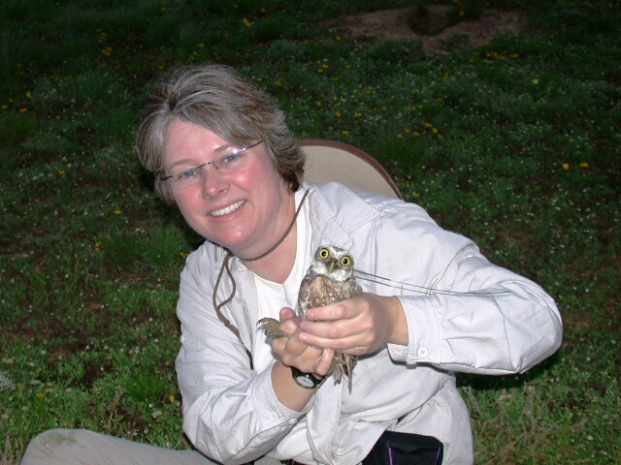Wild Pantex – Burrowing Owls
Article by Jim Ray, Pantex Wildlife Biologist/Scientist
This week I have a guest blogger, one that we have collaborated with on burrowing owl research. I will follow this up next week with more information on the research project itself.
Nancy McIntyre is Professor of Biological Sciences and Curator of Birds at Texas Tech University. She writes:
"Burrowing Owls are easy to overlook, especially when you’re traveling 55+ miles per hour. My first encounter with a Burrowing Owl was along a lonely prairie road in eastern Colorado, now 20 years ago. Recently transplanted from Georgia, I was traveling from point A to point B and marveling at the utter lack of trees, when a black-tailed prairie dog crossed the road in from of me. I slowed and realized that the road cut through an enormous prairie dog colony. Slowing further, I spotted a dumpy bird that flew from the ground to a fence post. I pulled abreast of the post, stopped, and beheld my first Burrowing Owl. I took a pair of binoculars from my glove compartment and focused them on the little guy's facial expression; one that was at once both cute and ornery. Yellow eyes glared at me with real menace, but given that their owner was less than nine inches tall, I couldn’t help but laugh out loud at the absurdity. Thus began my love affair with Burrowing Owls.
Burrowing Owls are among the most accessible owls in the world because they are diurnal and often live near human settlements. These traits are at odds with the typically secretive, nocturnal habits of other owls. Indeed, many Texans may see Burrowing Owls on a daily basis throughout much of the year and yet may never see another type of owl in their entire lives. However, many more Texans are unaware of the existence of owls so close by. Collaborations between Texas Tech University and Pantex have contributed to our understanding of their reproduction, behaviors, and habitat associations.
Burrowing Owls occur from Canada to the southern tip of South America, but they are not equally abundant over all of these regions. They are absent from forested areas, being birds of the wide open spaces of prairie and desert. And the owls do not occur in all portions of their range throughout the year: like most birds, they are migratory. Most Burrowing Owl individuals will migrate away from their summer breeding area to an overwintering location. For example, some owls that breed in Canada overwinter along the Texas coast. Burrowing Owls are primarily summer residents at Pantex, one of numerous breeding bird species that occur at the site. However, a few burrowing owls from points north can be found at Pantex during the winter.
Burrowing Owls rely upon other species to dig their burrows. Over much of the owls’ range, the primary burrow providers are black-tailed prairie dogs, which are too large to be owl prey. These colonial rodents live in “towns” of family groups in numerous burrows. Different burrows have different uses: some are nurseries whereas others are used as latrines. Many burrows may be unoccupied because of death or abandonment by residents. These empty burrows may be colonized by Burrowing Owls, where they raise 2-4 chicks, primarily on a diet of insects and small vertebrates like mice.
Listed as endangered in Canada and threatened in Mexico, the Burrowing Owl is a species of concern in the U.S. Burrowing Owls are disappearing from areas where they once occurred and are declining in most areas where they remain, primarily due to conversion of habitat for agriculture and urbanization, and especially to declines in prairie dog numbers. Construction of artificial burrows, protection of nesting sites during reproduction, and promoting appreciation of prairies and deserts and all their inhabitants will hopefully prevent our grandchildren from learning about Burrowing Owls in the same breath as the Dodo or Carolina Parakeet. These two species are no longer with us."

Photo: Dr. Nancy McIntyre and a burrowing owl.
